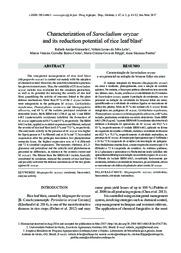Characterization of Sarocladium oryzae and its reduction potential of rice leaf blast.
Characterization of Sarocladium oryzae and its reduction potential of rice leaf blast.
Author(s): GUIMARÃES, R. A.; LOBO, V. L. da S.; CORTES, M. V. de C. B.; FILIPPI, M. C. C. de; PRABHU, A. S.
Summary: The integrated management of rice leaf blast (Magnaporthe oryzae) is carried out mainly with the adoption of chemical control. However, the search for alternative practices has grown in recent years. Thus, the variability of 28 Sarocladium oryzae isolates was evaluated for the cerulenin production, as well as its potential for reducing the severity of rice leaf blast, quantifying the activity of enzymes linked to the plant defense mechanisms. More than 55 % of the S. oryzae isolates were antagonistic to the pathogens M. oryzae, Cochliobolus miyabeanus, Thanatephorus cucumeris and Monographella albescens, and 60 % of the isolates produced cerulenin at detectable levels. Both BRM 6461 (296.0 ug mL-1) and BRM 6493 (undetectable cerulenin) inhibited the formation of M. oryzae appressoria in 89.5 % and 85 %, respectively. The BRM 6461 isolate, applied as conidial suspension and filtered, reduced the severity of rice leaf blast in 68.8 % and 75.5 %, respectively. The enzymatic activity in the presence of M. oryzae was higher for lipoxygenase at 5 h (filtered) and at 24 h and 72 h (conidial suspension) after the pathogen inoculation. For phenylalanine ammonia lyase, the highest expression was at 5 h (filtered) and 72 h (conidial suspension). The enzymes chitinase, B-1,3-glucanase and peroxidase and the salicylic acid phytohormone presented no differences, in relation to the controls (water and M. oryzae). The filtered from the BRM 6461 isolate, basically constituted by cerulenin, reduced the severity of rice leaf blast and possibly activated the defense mechanisms of the rice plants against M. oryzae.
Publication year: 2017
Types of publication: Journal article
Unit: Embrapa Rice & Beans
Observation
Some of Embrapa's publications are published as ePub files. To read them, use or download one of the following free software options to your computer or mobile device. Android: Google Play Books; IOS: iBooks; Windows and Linux: Calibre.
Access other publications
Access the Agricultural Research Database (BDPA) to consult Embrapa's full library collection and records.
Visit Embrapa Bookstore to purchase books and other publications sold by Embrapa.

